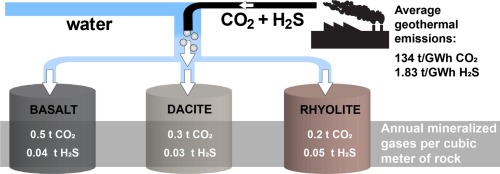International Journal of Greenhouse Gas Control ( IF 4.6 ) Pub Date : 2018-08-23 , DOI: 10.1016/j.ijggc.2018.07.011 Chiara Marieni , Jan Přikryl , Edda Sif Aradóttir , Ingvi Gunnarsson , Andri Stefánsson

|
Geothermal fluid utilization is considered one of the green energy sources. Yet, mitigation strategies must be applied to reduce the associated pollutants like carbon dioxide (CO2) and toxic hydrogen sulfide (H2S) emissions. One suggested method is the re-injection of the two gases back into the geothermal reservoir wherein carbon and sulfur are expected to mineralize naturally for a long-term underground storage. However, CO2 and H2S mineralization rates for natural systems are not well defined. To address the feasibility of such sequestration, experiments were conducted at 250 °C for several reservoir rock types, ranging from basaltic to silicic. Analysis of solution composition and secondary mineralogy confirmed the precipitation of Fe-Ca carbonates and Fe sulfide for all the rocks within days. The measured mineralization rates indicate that ∼0.2–0.5 t of CO2, and ∼0.03–0.05 t of H2S can be sequestrated annually per cubic meter of rock, depending on reservoir lithology and surface area. Calculations show that a total rock sequestration capacity of ∼0.03 km3 would be sufficient to store the annual world CO2 and H2S geothermal emissions. These findings indicate efficient abatement of CO2 and H2S at field conditions, confirming the strategy potential for at least the typical 50 years-lifetime of geothermal power plants.
中文翻译:

迈向“绿色”地热能:地热储层中碳和硫的共同矿化
地热流体利用被认为是绿色能源之一。但是,必须采取缓解策略来减少相关的污染物,例如二氧化碳(CO 2)和有毒的硫化氢(H 2 S)排放。一种建议的方法是将两种气体重新注入地热储层,其中碳和硫有望自然地矿化以长期地下储存。但是,CO 2和H 2天然系统的S矿化率尚未明确定义。为了解决这种隔离的可行性,我们在250°C下针对从玄武质到硅质的几种储层岩石进行了实验。溶液成分和次生矿物学的分析证实了几天内所有岩石的Fe-Ca碳酸盐和Fe硫化物的沉淀。测得的矿化速率表明,每立方米岩石每年可封存约0.2-0.5 t的CO 2和约0.03-0.05 t的H 2 S,这取决于储层的岩性和表面积。计算表明,总的岩石固存能力约为0.03 km 3,足以存储每年的世界CO 2和H 2。s地热排放。这些发现表明在野外条件下可以有效地减少CO 2和H 2 S,从而确认了至少在地热发电厂的典型50年使用寿命中的战略潜力。











































 京公网安备 11010802027423号
京公网安备 11010802027423号